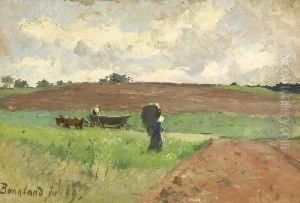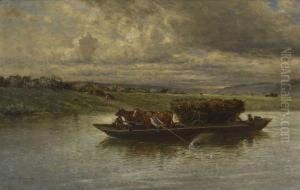Heinrich Ludwig Von Gleichen-Russwurm Paintings
Heinrich Ludwig von Gleichen-Russwurm was a German artist and nobleman, born on July 31, 1826, in the small town of Greifenstein in the Grand Duchy of Hesse. His family was part of the aristocracy, which provided him with the means and connections to pursue a career in the arts. Von Gleichen-Russwurm was not only an artist but also a writer and philosopher, which was not uncommon for educated individuals of his social standing during the 19th century.
Von Gleichen-Russwurm's artistic endeavors were primarily in the realm of painting and drawing. He was known for his landscape paintings, which often captured the romantic essence of the German countryside. His work was influenced by the Romantic movement, which was prevalent during his time. This movement emphasized emotion and individualism, a reaction against the industrial revolution and the aristocratic social and political norms of the Age of Enlightenment.
In addition to his painting, von Gleichen-Russwurm made significant contributions to German literature and philosophy. His intellectual pursuits reflected the broader interests of many artists of the period, who were engaged in discussions about the role of art and the artist in society. Von Gleichen-Russwurm's writings often dealt with themes of aesthetics, nature, and the human experience, tying back to the Romantic ideals that also permeated his visual art.
Throughout his life, von Gleichen-Russwurm maintained a close relationship with various intellectual and artistic circles. Despite his noble background, he was keenly aware of and engaged with the socio-political issues of his time. His work, both artistic and literary, often reflected a contemplative engagement with the world around him.
Heinrich Ludwig von Gleichen-Russwurm passed away on June 15, 1901. While not as widely recognized today as some of his contemporaries, his contributions to the arts during the 19th century remain a testament to the interplay of nobility, artistry, and intellectualism that characterized the lives of many European artists of his era. His legacy is preserved in the art and writings he left behind, which continue to offer insights into the Romantic spirit that defined his life and work.

